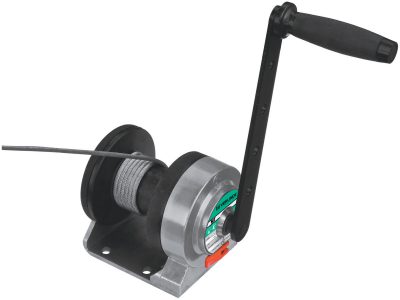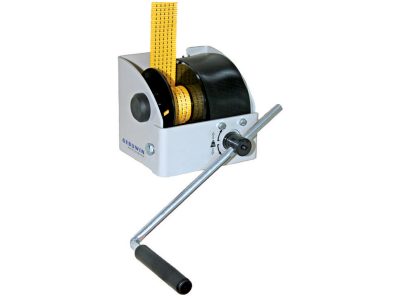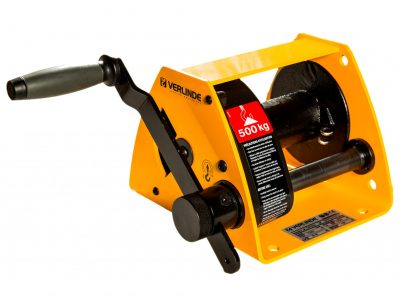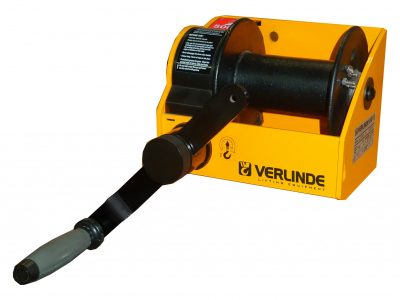Manual Winches
A range of manual winches from leading brands Verlinde and Gebuwin
We supply a wide variety of hand driven winches included worm gear and spur gear winches from market leading winch manufacturers Verlinde and Gebuwin, that provide a lifting capacity from 150kg to 500kg.











About our Manual Winches
When it comes to lifting, lowering, or pulling heavy loads, manual winches play a crucial role in various industries and applications. A manual winch, also known as a manual hand winch or hand-operated winch, is a mechanical device that utilises human effort to operate the lifting and lowering functions and Hoist UK has an extensive range of manual and electric winches for this type of application. In this basic guide, we will explore the different types of manual winches, their key features, and how to choose the right one for your specific lifting or pulling needs.
Types of Manual Winches
Based on load capacity
Manual winches come in various load capacities, ranging from light-duty to heavy-duty. The load capacity of a winch refers to the maximum weight it can handle effectively for your application. Manufacturers often categorise winches based on their load capacity to simplify the selection process for users.
Whether you need to lift a few kilograms or several tonnes, there's a manual winch designed to meet your requirements and we have an extensive range of these available with the ability to offer you advice on which best suits your application.
Based on design and construction
Manual winches are available in different designs to cater to diverse lifting and pulling applications. Some common types include spur gear manual winches, worm gear manual winches, and ratchet manual winches. Each design offers unique advantages, for instance, spur gear winches are known for their efficiency in lifting heavy loads, while worm gear winches are more suited to applications where a controlled and precise movement is essential.
Key features and benefits of each type
Spur Gear Manual Winches: These winches are renowned for their exceptional strength and durability, making them suitable for heavy-duty lifting tasks. The design ensures smooth and efficient operation even under considerable stress, making them ideal for demanding industrial environments.
Worm Gear Manual Winches: Worm gear winches provide a significant mechanical advantage, making it easier to lift heavier loads with less effort by the operator. They are often used in applications that require slow and controlled lifting or lowering, ensuring safety and precision.
Ratchet Manual Winches: These winches are popular for their versatility and ease of use. They are commonly employed in pulling applications and feature a ratcheting mechanism that prevents the load from slipping back during operation, ensuring enhanced safety and can be used on-site by installation engineers for load positioning and pulling applications.

Choosing the Right Manual Winch
Selecting the most suitable manual winch for your specific needs involves considering various factors:
Application (Lifting or Pulling)
Determine whether you require a manual winch for lifting heavy loads vertically or pulling loads horizontally. The application could also be combined if you are pulling a load up a slope.
Different winches are designed for different specific applications, so choosing the right type ensures optimal performance and safety. Hoist UK can help you with selection from the range of equipment provided by our partnerships with global lifting equipment and winch manufacturers such as Gebuwin who are based in the Netherlands or Verlinde who are based in France, and both represented worldwide.
Free Spooling Drum
A free spooling drum allows the wire rope to be pulled out without turning the winch handle, offering convenience during setup.
The free spool enables the operator to quickly pull the hook or lifting attachment of the winch to the position it needs to be in to start the operation, so significant time can be saved where the operator does not need to manually feed the hook out through the mechanics of the winch.
Not all winches have this feature, so consider its importance based on your operational requirements and rest assured that we can provide this on a significant amount of models in the Hoist UK range of equipment.
Height of Lift
The height or distance you need to lift, lower, or pull the load plays a crucial role in winch selection. Ensure the winch you choose has the necessary lifting or pulling capacity to cover the required height or distance you need safely and efficiently.
Length of Wire Rope Needed
The length of the wire rope should be sufficient for your specific application. Consider the distance between the winch and the load to determine the appropriate length required. As the rope is stored on the drum of the winch, this is a key consideration in the selection of the correct winch for your application.
Load Capacity and Working Conditions (Safe Working Load)
Always ensure that the manual winch's load capacity matches or exceeds the weight of the loads you intend to handle. Additionally, consider the working conditions, as factors such as temperature, moisture, and terrain can impact the winch's performance.
If your winch is being used for pulling application, you will need to consider whether the load is being pulled horizontally or up an incline and you may also need to consider the coefficient of friction between the load and the surface it is being pulled along.
There are several rules of thumb that Hoist UK can apply with applications such as this if a calculation of the pulling force needed for a specific application is not known, so please consult us.
Environment - Corrosion Resistance or Stainless Steel
In corrosive environments or marine applications, it is crucial to choose a winch with corrosion resistance properties or opt for stainless steel models to ensure durability and longevity.
Hoist UK have a range of winches with different finishes to suit the harsher working environments that manual winches are sometimes used in. We can supply winches with standard painted finishes, zinc plated and stainless steel to cover environmental conditions.
Mounting Options and Compatibility
Consider the mounting options available for the winch and ensure compatibility with your equipment or mounting surface.
Some winches may require specific adapters or brackets for installation and we can provide assistance and manufacturing services to design and develop bespoke or tailored mounting brackets for your lifting or pulling winches using our standard range of equipment.
Safety Features and Certifications
Modern hand winches can be supplied with built-in safety features, such as automatic brakes, to prevent accidental load slippage or unwinding.
Our partnerships with leading global manufacturers such as Gebuwin and Verlinde allow us to supply winches that adhere to industry and European standards and carry relevant certifications for quality assurance.
Maintenance Requirements
Regular maintenance is vital to keep the manual winch in optimal working condition, which is the normal condition for all mechanical lifting appliances. You need to check the manufacturer's guidelines for maintenance requirements and choose winches that offer ease of servicing and work with a partner who can provide these services to you to ensure your equipment stays fit for purpose and safe to use.
In collaboration with industry-leading partners like Verlinde and Gebuwin, our range of manual winches offers reliable solutions for your lifting and pulling needs. Verlinde is renowned for its expertise in material handling equipment, while Gebuwin are a specialist in high-quality hand winches for various applications.
Selecting the right manual winch involves evaluating load capacity, design, features, and the specific demands of your application. Investing in high-quality manual winches will not only enhance productivity but also ensures safety in your operations, ensuring smooth and efficient lifting, lowering, or pulling of heavy loads.
Frequently Asked Questions
1. How much weight can a manual winch pull?
The weight capacity of a manual winch varies based on its design and construction. Manual winches are available in a wide range of load capacities, from light-duty options capable of pulling a few hundred kilograms to heavy-duty models capable of handling equipment weighing multiple tonnes.
Ask us for advice to help review the specifications to determine the load capacity of a particular manual winch. Manual winches can be used to pull loads up to 40,000kg (40 tonnes), however, their lifting capacity on the same winch is considerably lower.
2. What are the advantages of using a manual winch over other types?
Manual winches offer several advantages over other types of winches. Some key benefits include:
Simplicity: Manual winches are easy to operate, requiring minimal training and no external power source.
Versatility: They can be used in various environments and applications, both indoors and outdoors.
Cost-Effective: Manual winches are typically more budget-friendly compared to powered winches, making them an attractive option for many users who have low-duty applications.
Portability: Their lightweight and compact design makes manual winches easy to transport and install in different locations if required.
3. What load capacity should I choose for my specific lifting needs?
Selecting the appropriate load capacity depends on the weight of the loads you need to lift or pull in your chosen application. Always ensure that the manual winch's load capacity exceeds the maximum weight of the load to be lifted. It's crucial to consider potential future needs with spare capacity and choose a winch with a slightly higher load capacity if you expect your lifting requirements to increase anytime in the future.
4. Can a manual winch be used for vertical lifting and horizontal pulling?
Yes, most manual winches are versatile and can be used for both vertical and horizontal lifting applications. Pulling a load is less onerous, so the winch will typically have a larger capacity for pulling than lifting, as the load is not suspended on the mechanical elements of the winch in its use.
It's also essential to check the manufacturer's guidelines and discuss these with us to ensure recommendations on the winch's safe and efficient operation in different orientations are maintained.
5. Are manual winches suitable for outdoor applications?
Yes, manual winches can be suitable for outdoor applications, provided they are designed to withstand outdoor conditions. Hoist UK supply a range of features such as zinc plating and stainless-steel components to help protect equipment from the elements.
For outdoor use, consider manual winches with corrosion-resistant coatings, like zinc plating or those made from stainless steel to ensure durability and longevity. Our partnership with leading manufacturers like Gebuwin and Verlinde ensures high-quality winches which can be supplied with features to make them more suited for outdoor use.
6. What safety precautions should I take when using a manual winch?
Safety should always be a top priority when using a manual winch. Follow these essential safety precautions:
- Adhere to the winch's load capacity and avoid overloading.
- Regularly inspect the winch for any signs of wear, damage, or corrosion/rust.
- Use appropriate personal protective equipment (PPE) like gloves and safety glasses when operating the winch.
- Use equipment which comes with either a UK or EU Declaration of Conformity from a reputable equipment manufacturer, such as Hoist UK, Gebuwin or Verlinde.
- Ensure regular statutory inspection under the Lifting Operations and Lifting Equipment Regulations (LOLER).
- Ensure proper training for all operators to use the winch correctly and safely.
- Keep unauthorised persons at a safe distance during winching operations.
- Never exceed the winch's recommended lifting or pulling capacity.
7. How often should I lubricate my manual winch?
Lubrication is essential to maintain the optimal performance and longevity of your manual winch. The frequency of lubrication depends on the winch's usage and the manufacturer's recommendations.
As a general guideline, consider lubricating the winch at least every six months or more frequently if it is frequently used or exposed to harsh environments. All equipment should be serviced by a competent person on a regular basis.
8. What should I do if my winch becomes jammed?
If your manual winch becomes jammed or encounters any operational issues, stop using it immediately to prevent further damage. Carefully inspect the winch for any obstructions, dirt, or debris that may be causing the jam.
Refer to the winch's user manual for troubleshooting guidance or talk to your Hoist UK representative if you cannot resolve the issue safely. Our partnership with leading winch manufacturers like Gebuwin and Verlinde ensures access to reliable customer support and service for your winching needs.
9. Can a manual winch be used underwater or in submerged conditions?
While manual winches can be designed to withstand harsh environments, not all manual winches are suitable for underwater or submerged applications.
Some manual winches are specifically engineered for marine use or environments where they may encounter water exposure, but not in a submerged condition. If you require a manual winch for underwater operations, ensure you select a model with appropriate waterproofing and corrosion-resistant features.
10. Are there any specific guidelines for using a manual winch in extreme weather conditions?
Using a manual winch in extreme weather conditions requires additional precautions. Extremely hot or cold temperatures can affect the winch's performance and durability, so it's always advised to consult with us first.
If operating in high-temperature environments, consider selecting winches with heat-resistant components. In cold climates, ensure that the winch is adequately lubricated and operates smoothly in freezing conditions. Always consult the supplier or manufacturer's guidelines for any specific recommendations regarding extreme weather usage.




